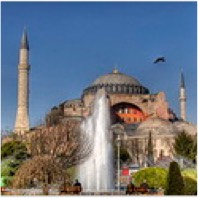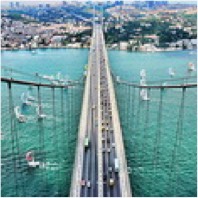Hagia Sophia

Hagia Sophia is a great architectural beauty and the most important monument both for Byzantine and for Ottoman Empires. Once a church, later a mosque, and now a museum at the Turkish Republic. Hagia Sophia has always been the precious of its time. It was the most important Byzantine architecture found in İstanbul.
Besides the religious subjects of the mosaics used to decorate the interior surfaces, the emperor was also used as a subject. One mosaic depicts the Virgin Mary with the emperors Justinian and Constantine sitting at her sides. Another mosaic shows Jesus sitting on a throne with the Emperor Leon 7 kneeling before him. Another mosaic is of Mary and John the Baptist imploring Jesus for mercy in the name of the people. All these mosaics bear traces of Hellenistic influences. There are also several mosaic "portraits" of other members of the imperial family. Portrait art was very advanced during the Byzantine period. The original mosaics of the church were severely damaged by the Iconoclasts, but new mosaics replaced the former in the 9th century after the period of Iconoclasm had disappeared. After Fatih captured the city this structure was used for worship by the Moslems.
From the date of its dedication in 360 until 1453, it served as the cathedral of Constantinople ( Istanbul ), except between 1204 and 1261, when it was converted to a Roman Catholic cathedral. Famous in particular for its massive dome, it is considered the epitome of Byzantine architecture and is said to have "changed the history of architecture. The current building was originally constructed as a church between 532 and 537 on the orders of the Byzantine Emperor Justinian and was the third Church of the Holy Wisdom to occupy the site, the previous two having both been destroyed by rioters. It was designed by Isidore of Miletus, a physicist, and Anthemius of Tralles, a mathematician.
In 1453, Constantinople was conquered by the Ottoman Turks under Sultan Mehmed II, who subsequently ordered the building converted into a mosque. The bells, altar, iconostasis, and sacrificial vessels were removed and many of the mosaics were plastered over. Islamic features ( such as the mihrab, minbar, and four minarets )were added while in the possession of the Ottomans.. In 1935 Hagia Sophia was converted into a museum, and it is now one of Turkey's most popular museums.







